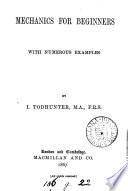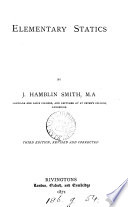 | Henry William Watson, Edward John Routh - Mathematics - 1860 - 240 pages
...magnitude, prove it also for the direction, of the resultant. 2. When three forces acting at a point are in equilibrium, each force is proportional to the sine of the angle between the other two. Two equal particles, each attracting with a force varying directly as the distance, are situated at... | |
 | Henry William Watson, Edward John Routh - Mathematics - 1860 - 240 pages
...magnitude, prove it also for the direction, of the resultant. 2. When three forces acting at a point are in equilibrium, each force is proportional to the sine of the angle between the other two. Two equal particles, each attracting with a force varying directly as the distance, are situated at... | |
 | Stephen Parkinson - Dynamics - 1863 - 396 pages
...their directions are not parallel : — (i) Their lines of action must meet in a point, Art. (22). (ii) Each force is proportional to the sine of the angle between the other two, the direction of each force lying without the angle formed by the other two, Art. (23). For this latter... | |
 | Isaac Todhunter - Mechanics - 1867 - 368 pages
...of a triangle perpendicular to the lines of action. 38. If three forces acting on a particle keep it in equilibrium, each force is proportional to the sine of the angle between the directions of the other two. Let forces P, Q, R acting on a particle at 0 keep it in equilibrium. Then,... | |
 | Isaac Todhunter - Mechanics - 1867 - 372 pages
...of a triangle perpendicular to the lines of action. 38. If three forces acting on a particle keep it in equilibrium, each force is proportional to the sine of the angle between the directions of the other two. Let forces P, Q, R acting on a particle at 0 keep it in equilibrium. Then,... | |
 | Ephraim Chambers - Encyclopedias and dictionaries - 1870 - 872 pages
...substituting the sines of the supplementary angles) : : ein. QAR' : sin. PAH' : sin. PAQ ; that is, each force is proportional to the sine of the angle between the directions of the other tw o. TRIA'NGULAR NUMBERS. See FIOCRAT* NUMBERS. TRIANGULATION is the operation... | |
 | James Hamblin Smith - Statics - 1871 - 148 pages
...are in equilibrium : .-. MN:NO: OM=P:Q:R; and the magnitude of R' = magnitude of R, /. MN :NO xxxix. If three forces, acting at a point, be in equilibrium, each force is proportional to the sine of the angle contained between the directions of the other two, /F Let P, Q, R be the three forces : a, p,... | |
 | J W. Mulcaster - 1871 - 242 pages
...DC-.CA = sin A CD : sin CAD: sin ADC = sin Q"R : sin P"R : sin P A Q. Hence, if three forces acting on a point be in equilibrium, each force is proportional to the sine of the angle contained by the other two. 39. Cor. 2. It is manifest from the above that three forces acting... | |
 | W. G. Willson - Dynamics - 1874 - 294 pages
...since the sines of supplemental angles are equal, when three forces are in equilibrium at a point, each force is proportional to the sine of the angle between the other two. On account of the importance of this proposition an independent proof will be given further on. Cor.... | |
 | George Wightwick - 1875 - 394 pages
...forces is equal and opposite to the resultant of the other two; or if three forces as above keep a point in equilibrium, each force is proportional to the sine of the angle between the directions of the other two. If three forces acting on a point keep it in equilibrium, a triangle having... | |
| |